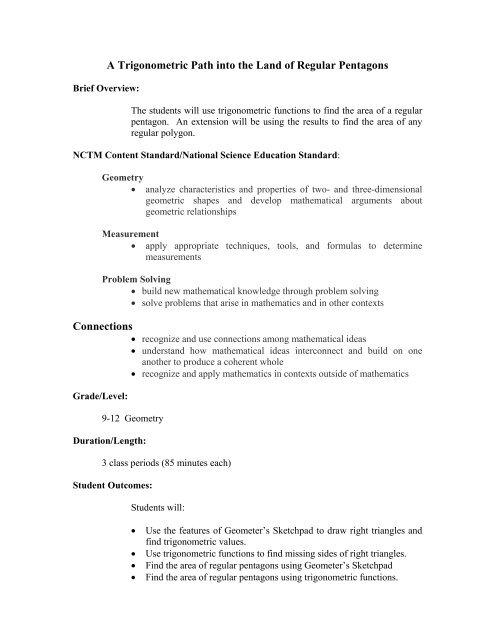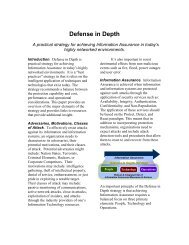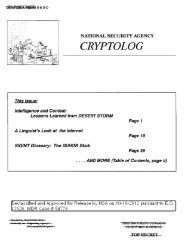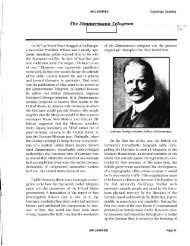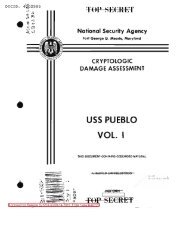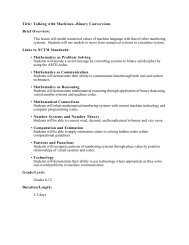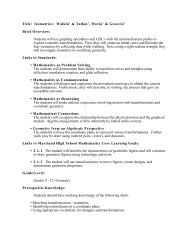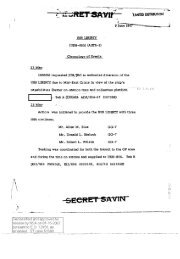A Trigonometric Path into the Land of Regular Pentagons - National ...
A Trigonometric Path into the Land of Regular Pentagons - National ...
A Trigonometric Path into the Land of Regular Pentagons - National ...
Create successful ePaper yourself
Turn your PDF publications into a flip-book with our unique Google optimized e-Paper software.
A <strong>Trigonometric</strong> <strong>Path</strong> <strong>into</strong> <strong>the</strong> <strong>Land</strong> <strong>of</strong> <strong>Regular</strong> <strong>Pentagons</strong><br />
Brief Overview:<br />
The students will use trigonometric functions to find <strong>the</strong> area <strong>of</strong> a regular<br />
pentagon. An extension will be using <strong>the</strong> results to find <strong>the</strong> area <strong>of</strong> any<br />
regular polygon.<br />
NCTM Content Standard/<strong>National</strong> Science Education Standard:<br />
Geometry<br />
• analyze characteristics and properties <strong>of</strong> two- and three-dimensional<br />
geometric shapes and develop ma<strong>the</strong>matical arguments about<br />
geometric relationships<br />
Measurement<br />
• apply appropriate techniques, tools, and formulas to determine<br />
measurements<br />
Problem Solving<br />
• build new ma<strong>the</strong>matical knowledge through problem solving<br />
• solve problems that arise in ma<strong>the</strong>matics and in o<strong>the</strong>r contexts<br />
Connections<br />
• recognize and use connections among ma<strong>the</strong>matical ideas<br />
• understand how ma<strong>the</strong>matical ideas interconnect and build on one<br />
ano<strong>the</strong>r to produce a coherent whole<br />
• recognize and apply ma<strong>the</strong>matics in contexts outside <strong>of</strong> ma<strong>the</strong>matics<br />
Grade/Level:<br />
9-12 Geometry<br />
Duration/Length:<br />
3 class periods (85 minutes each)<br />
Student Outcomes:<br />
Students will:<br />
• Use <strong>the</strong> features <strong>of</strong> Geometer’s Sketchpad to draw right triangles and<br />
find trigonometric values.<br />
• Use trigonometric functions to find missing sides <strong>of</strong> right triangles.<br />
• Find <strong>the</strong> area <strong>of</strong> regular pentagons using Geometer’s Sketchpad<br />
• Find <strong>the</strong> area <strong>of</strong> regular pentagons using trigonometric functions.
Materials and Resources:<br />
• Geometer’s Sketchpad<br />
• Scientific or Graphing Calculator<br />
• Student Worksheets #1 thru 7<br />
• Transparencies <strong>of</strong> Notes <strong>of</strong> Worksheet #3<br />
Prerequisite Knowledge:<br />
Students should have working knowledge <strong>of</strong> <strong>the</strong> following skills:<br />
• Identify <strong>the</strong> opposite and adjacent sides <strong>of</strong> a right triangle with respect<br />
to an angle.<br />
• Understand sine, cosine, and tangent function ratios.<br />
• Construct segments and perpendicular lines in Sketchpad.<br />
How to Use These Lessons:<br />
Development/Procedures:<br />
Lesson 1<br />
These lessons are designed to be used where students have access to a<br />
computer lab with Geometer’s Sketchpad. If a computer lab is not<br />
available, <strong>the</strong> lessons can be easily adapted to allow Sketchpad to be used<br />
as a demonstration tool and students can complete <strong>the</strong> worksheets.<br />
If Sketchpad is not available, <strong>the</strong> lessons could be adapted to be used with<br />
Cabri. If only Cabri Jr. is available, Lesson 1 could be adapted.<br />
Preassessment/Launch (5 minutes)<br />
• To begin <strong>the</strong> class, hand out Worksheet #1: Investigating<br />
Trig Functions to each student. Review <strong>the</strong> trig function equations<br />
with <strong>the</strong> students and have <strong>the</strong>m fill in <strong>the</strong> appropriate ratios.<br />
Teacher Facilitation (35 minutes)<br />
• Work with students to continue <strong>the</strong> worksheet. They will<br />
be using Sketchpad to demonstrate <strong>the</strong> sine function as a ratio.<br />
Student Application (45 minutes)<br />
• Have students work independently to complete <strong>the</strong><br />
worksheet. They will be using Sketchpad to demonstrate <strong>the</strong> cosine<br />
and tangent functions as ratios.<br />
• Have students complete Worksheet #2: Extra Practice. If<br />
necessary, <strong>the</strong>y may complete for homework.<br />
•
Embedded Assessment<br />
• The teacher should monitor student progress on <strong>the</strong><br />
worksheet as an ongoing assessment.<br />
Reteaching/Extension<br />
• For those who have understood <strong>the</strong> lesson, use <strong>the</strong> concepts learned to<br />
extend to find <strong>the</strong> missing angles in right triangles on <strong>the</strong> Extension<br />
Worksheet: Finding <strong>the</strong> Missing Angle<br />
Lesson 2<br />
Preassessment/Launch (5 minutes)<br />
• To begin <strong>the</strong> class, hand out Worksheet #3: Notes –<br />
Finding <strong>the</strong> Missing Side<br />
• Review <strong>the</strong> first part <strong>of</strong> <strong>the</strong> notes for students to recall how to set<br />
up trig functions.<br />
Teacher Facilitation (40 minutes)<br />
• Continue with <strong>the</strong> Notes worksheet. Uncover lines <strong>of</strong> text<br />
as you go and students can fill in <strong>the</strong> appropriate spaces.<br />
• These notes show 3 examples <strong>of</strong> how to use trig functions<br />
to find <strong>the</strong> missing sides <strong>of</strong> right triangles.<br />
• After each example, <strong>the</strong> teacher could use Sketchpad to<br />
verify for <strong>the</strong> students that <strong>the</strong> value does in fact match what <strong>the</strong><br />
students have determined.<br />
Student Application (25 minutes)<br />
• Worksheet #4: Practice Finding Missing Sides<br />
Embedded Assessment<br />
• The teacher should monitor student progress on <strong>the</strong><br />
worksheets as an ongoing assessment.<br />
Reteaching/Extension (15 minutes)<br />
• Worksheet #5: Trig Word Problems<br />
• This worksheet can also be assigned for homework<br />
depending on time.<br />
• As an Extension, Problem #6 can be used as a Bonus<br />
Problem for students that have understood <strong>the</strong> concepts.
Lesson 3<br />
Preassessment/Launch (10 minutes)<br />
• Review <strong>the</strong> answers to Worksheet #5: Trig Word Problems and collect<br />
for a grade.<br />
Teacher Facilitation (30 minutes)<br />
• Hand out Worksheet #6: Finding <strong>the</strong> Area <strong>of</strong> <strong>Regular</strong><br />
<strong>Pentagons</strong><br />
• Work with students to continue <strong>the</strong> worksheet. They will<br />
be using Sketchpad to demonstrate <strong>the</strong> sine function as a ratio.<br />
Student Application (45 minutes)<br />
• Have students work independently to complete <strong>the</strong><br />
worksheet.<br />
• Have students complete Worksheet #7: Pentagon Practice.<br />
They should not use Sketchpad. If necessary, <strong>the</strong>y may complete for<br />
homework.<br />
Embedded Assessment<br />
• The teacher should monitor student progress on <strong>the</strong><br />
worksheets as an ongoing assessment.<br />
Reteaching/Extension<br />
• For those who have understood <strong>the</strong> lesson, use <strong>the</strong> concepts learned to<br />
extend to find <strong>the</strong> areas <strong>of</strong> o<strong>the</strong>r regular polygons.<br />
Summative Assessment:<br />
Quiz: Trig Functions and Area <strong>of</strong> <strong>Regular</strong> Polygons covers <strong>the</strong> concepts<br />
over <strong>the</strong> last three lessons. Problem #14 is an ECR. For grading use <strong>the</strong><br />
Maryland State Rubric for HSA at<br />
www.mdk12.org/instructin/curriculum/hsa/geometry/instructional.html<br />
Authors:<br />
Crissy Shevchenko<br />
Watkins Mill High School<br />
Montgomery County, MD<br />
Sherry Wolfe<br />
Nor<strong>the</strong>ast High School<br />
Anne Arundel County, MD
Name ________________________________ Date_____________________ Period__________<br />
Worksheet #1: Investigating Trig Functions<br />
Review (Complete <strong>the</strong> ratio statement below using <strong>the</strong> given triangle.)<br />
SinB =<br />
p<br />
t<br />
C o s B =<br />
TanB =<br />
r<br />
B<br />
opposite<br />
hypotenuse<br />
adjacent<br />
hypotenuse<br />
opposite<br />
adjacent<br />
Sin B = ____________<br />
Cos B = _______________ Tan B = ________________<br />
Lesson<br />
1. Open Geometer’s Sketchpad.<br />
2. Construct a right triangle.<br />
3. Show labels for <strong>the</strong> vertices.<br />
4. Choose your point <strong>of</strong> view angle (reminder: it can not be <strong>the</strong> right angle) and measure <strong>the</strong><br />
angle. Place your answer in <strong>the</strong> appropriate column in <strong>the</strong> chart below.<br />
5. Label <strong>the</strong> sides <strong>of</strong> <strong>the</strong> triangle as opposite, adjacent, and hypotenuse based on your point <strong>of</strong><br />
view angle.<br />
6. Use <strong>the</strong> calculate function in Sketchpad to calculate <strong>the</strong> sine <strong>of</strong> your point <strong>of</strong> view angle.<br />
Place your answer in <strong>the</strong> appropriate column in <strong>the</strong> chart below.<br />
7. Measure <strong>the</strong> lengths <strong>of</strong> <strong>the</strong> opposite side, adjacent side, and hypotenuse. Place your answer in<br />
<strong>the</strong> appropriate column in <strong>the</strong> chart below.<br />
8. Using Sketchpad, calculate <strong>the</strong> sine function as a ratio based on your side lengths. Place your<br />
answer in <strong>the</strong> appropriate column in <strong>the</strong> chart below.<br />
9. Complete <strong>the</strong> following table with your data.<br />
Degree <strong>of</strong> your<br />
point <strong>of</strong> view<br />
angle<br />
Sin <strong>of</strong> <strong>the</strong><br />
degree<br />
Opposite<br />
side length<br />
Adjacent side<br />
length<br />
Hypotenuse<br />
length<br />
Sin = opp<br />
hyp
10. Change <strong>the</strong> measure <strong>of</strong> your point <strong>of</strong> view angle. Complete <strong>the</strong> following chart two more<br />
times with <strong>the</strong> new measures.<br />
Degree <strong>of</strong> your<br />
point <strong>of</strong> view<br />
angle<br />
Sin <strong>of</strong> <strong>the</strong><br />
degree<br />
Opposite<br />
side length<br />
Adjacent side<br />
length<br />
Hypotenuse<br />
length<br />
Sin = opp<br />
hyp<br />
11. What conclusions can you draw from <strong>the</strong> answers to step 6 and step 8?<br />
______________________________________________________________________________<br />
______________________________________________________________________________<br />
______________________________________________________________________________<br />
______________________________________________________________________________<br />
________________________________________________<br />
12. Do you think <strong>the</strong> same conclusion could be said for calculating cosine and tangent? Why or<br />
Why not?<br />
______________________________________________________________________________<br />
______________________________________________________________________________<br />
______________________________________________________________________________<br />
______________________________________________________________________________<br />
________________________________________________<br />
13. Use <strong>the</strong> above steps to complete <strong>the</strong> following chart for cosine. Please remember that in step<br />
6 and step 8 you are now calculating cosine.<br />
Degree <strong>of</strong> your<br />
point <strong>of</strong> view<br />
angle<br />
Cos <strong>of</strong> <strong>the</strong><br />
degree<br />
Opposite<br />
side length<br />
Adjacent side<br />
length<br />
Hypotenuse<br />
length<br />
Cos = adj<br />
hyp
14. Use <strong>the</strong> above steps to complete <strong>the</strong> following chart for tangent. Please remember that in<br />
step 6 and step 8 you are now calculating tangent.<br />
Degree <strong>of</strong> your<br />
point <strong>of</strong> view<br />
angle<br />
Tan <strong>of</strong> <strong>the</strong><br />
degree<br />
Opposite<br />
side length<br />
Adjacent side<br />
length<br />
Hypotenuse<br />
length<br />
Tan = opp<br />
adj<br />
15. Do your findings agree with your hypo<strong>the</strong>sis to question number 12?<br />
______________________________________________________________________________<br />
______________________________________________________________________________<br />
______________________________________________________________________________<br />
______________________________________________________________________________<br />
______________________________________________________________________________
Name __________________________________ Date _________________ Period ___________<br />
Worksheet #1: Investigating Trig Functions<br />
ANSWER KEY<br />
Review (Complete <strong>the</strong> ratio statement below using <strong>the</strong> given triangle.)<br />
SinB =<br />
p<br />
t<br />
C o s B =<br />
TanB =<br />
r<br />
B<br />
opposite<br />
hypotenuse<br />
adjacent<br />
hypotenuse<br />
opposite<br />
adjacent<br />
Sin B = p/t Cos B = r/t Tan B = p/r<br />
Lesson<br />
Answers will vary. Sample answers are given.<br />
1. Open Geometer’s Sketchpad.<br />
2. Construct a right triangle.<br />
3. Show labels for <strong>the</strong> vertices.<br />
4. Choose your point <strong>of</strong> view angle (reminder: it can not be <strong>the</strong> right angle) and measure <strong>the</strong><br />
angle. Place your answer in <strong>the</strong> appropriate column in <strong>the</strong> chart below.<br />
5. Label <strong>the</strong> sides <strong>of</strong> <strong>the</strong> triangle as opposite, adjacent, and hypotenuse based on your point <strong>of</strong><br />
view angle.<br />
6. Use <strong>the</strong> calculate function in Sketchpad to calculate <strong>the</strong> sine <strong>of</strong> your point <strong>of</strong> view angle.<br />
Place your answer in <strong>the</strong> appropriate column in <strong>the</strong> chart below.<br />
7. Measure <strong>the</strong> lengths <strong>of</strong> <strong>the</strong> opposite side, adjacent side, and hypotenuse. Place your answer in<br />
<strong>the</strong> appropriate column in <strong>the</strong> chart below.<br />
8. Using Sketchpad, calculate <strong>the</strong> sine function as a ratio based on your side lengths. Place your<br />
answer in <strong>the</strong> appropriate column in <strong>the</strong> chart below.<br />
9. Complete <strong>the</strong> following table with your data.<br />
Degree <strong>of</strong> your<br />
point <strong>of</strong> view<br />
angle<br />
Sin <strong>of</strong> <strong>the</strong><br />
degree<br />
Opposite<br />
side length<br />
Adjacent side<br />
length<br />
Hypotenuse<br />
length<br />
Sin = opp<br />
hyp<br />
67.4º .9232 12 5 13 12/13 ≈ .9231
10. Change <strong>the</strong> measure <strong>of</strong> your point <strong>of</strong> view angle. Complete <strong>the</strong> following chart two more<br />
times with <strong>the</strong> new measures. Answers will vary.<br />
Degree <strong>of</strong> your<br />
point <strong>of</strong> view<br />
angle<br />
Sin <strong>of</strong> <strong>the</strong><br />
degree<br />
Opposite<br />
side length<br />
Adjacent side<br />
length<br />
Hypotenuse<br />
length<br />
Sin = opp<br />
hyp<br />
11. What conclusions can you draw from <strong>the</strong> answers to step 6 and step 8?<br />
Students should be able to recognize that using <strong>the</strong> trig function is <strong>the</strong> same as <strong>the</strong> ratio <strong>of</strong><br />
<strong>the</strong> side lengths.<br />
12. Do you think <strong>the</strong> same conclusion could be said for calculating cosine and tangent? Why or<br />
Why not? Answers will vary.<br />
______________________________________________________________________________<br />
______________________________________________________________________________<br />
______________________________________________________________________________<br />
______________________________________________________________________________<br />
________________________________________________<br />
13. Use <strong>the</strong> above steps to complete <strong>the</strong> following chart for cosine. Please remember that in step<br />
6 and step 8 you are now calculating cosine. Answers will vary.<br />
Degree <strong>of</strong> your<br />
point <strong>of</strong> view<br />
angle<br />
Cos <strong>of</strong> <strong>the</strong><br />
degree<br />
Opposite<br />
side length<br />
Adjacent side<br />
length<br />
Hypotenuse<br />
length<br />
Cos = adj<br />
hyp
14. Use <strong>the</strong> above steps to complete <strong>the</strong> following chart for tangent. Please remember that in<br />
step 6 and step 8 you are now calculating tangent. Answers will vary.<br />
Degree <strong>of</strong> your<br />
point <strong>of</strong> view<br />
angle<br />
Tan <strong>of</strong> <strong>the</strong><br />
degree<br />
Opposite<br />
side length<br />
Adjacent side<br />
length<br />
Hypotenuse<br />
length<br />
Tan = opp<br />
adj<br />
15. Do your findings agree with your hypo<strong>the</strong>sis to question number 12?<br />
Students should be able to recognize that no matter what trig function <strong>the</strong>y use it will<br />
correspond to <strong>the</strong> ratio <strong>of</strong> <strong>the</strong> side lengths.
Name __________________________________ Date ____________________ Period ________<br />
Worksheet #2 – Extra Practice<br />
Use <strong>the</strong> right triangle to answer <strong>the</strong> following questions.<br />
E<br />
a<br />
b<br />
D<br />
c<br />
F<br />
1. Sin D = ____________ 2. Cos E = ______________ 3. Tan D = ____________<br />
4. Tan E = ____________ 5. Sin E = ______________ 6. Cos D = ____________<br />
Use <strong>the</strong> right triangle to write <strong>the</strong> ratio and <strong>the</strong> decimal approximation.<br />
E<br />
13<br />
5<br />
D<br />
12<br />
F<br />
1. Sin D = _________ ≈ _________ 2. Cos E = ________<br />
≈ _________<br />
3. Tan D = ________ ≈ __________ 4. Tan E = ________ ≈ _________<br />
5. Sin E = _________ ≈ __________ 6. Cos D = ________ ≈ _________
Use your calculator to find <strong>the</strong> values for each problem.<br />
Reminder: If using a graphing calculator, <strong>the</strong> mode should be degree.<br />
7. Sin 33º ≈ ________ 8. Cos 85º<br />
≈ _________<br />
9. Tan 2º ≈ ________ 10. Tan 66º<br />
11. Cos 45º ≈ _______ 12. Sin 74º<br />
≈ ________<br />
≈ _________<br />
Use <strong>the</strong> right triangle to find each <strong>of</strong> <strong>the</strong> following.<br />
T<br />
1<br />
5<br />
S<br />
2<br />
R<br />
13. Sin _________ = 1 14. Cos ___________ = 2<br />
5 5<br />
15. Tan ________ = 2 16. Tan ___________ = 1<br />
2<br />
17. Cos _________ = 1 18. Sin ____________ = 2<br />
5 5
Worksheet #2 – Extra Practice<br />
ANSWER KEY<br />
Use <strong>the</strong> right triangle to answer <strong>the</strong> following questions.<br />
E<br />
a<br />
b<br />
D<br />
c<br />
F<br />
1. Sin D = b/a 2. Cos E = b/a 3. Tan D = b/c<br />
4. Tan E = c/b 5. Sin E = c/a 6. Cos D = c/a<br />
Use <strong>the</strong> right triangle to write <strong>the</strong> ratio and <strong>the</strong> decimal approximation.<br />
E<br />
13<br />
5<br />
D<br />
12<br />
F<br />
1. Sin D = 5/13 ≈ .3864 2. Cos E = 5/13 ≈ .3864<br />
3. Tan D = 5/12 ≈ .4167 4. Tan E = 12/5 ≈ 2.4<br />
5. Sin E = 12/13 ≈ .9231 6. Cos D = 12/13 ≈ .9231
Use your calculator to find <strong>the</strong> values for each problem.<br />
Reminder: If using a graphing calculator, <strong>the</strong> mode should be degree.<br />
7. Sin 33º ≈ .5446 8. Cos 85º ≈ .0872<br />
9. Tan 2º ≈ .0349 10. Tan 66º ≈ 2.2460<br />
11. Cos 45º ≈ .7071 12. Sin 74º ≈ .9613<br />
Use <strong>the</strong> right triangle to find each <strong>of</strong> <strong>the</strong> following.<br />
T<br />
1<br />
5<br />
S<br />
2<br />
R<br />
13. Sin R = 1 14. Cos R = 2<br />
5 5<br />
15. Tan T = 2 16. Tan R = 1<br />
2<br />
17. Cos T = 1 18. Sin T = 2<br />
5 5
Name _________________________________ Date _________________ Period ___________<br />
Extension Worksheet: Finding <strong>the</strong> Missing Angle<br />
You can find <strong>the</strong> degree measure <strong>of</strong> a missing angle <strong>of</strong> a right triangle with <strong>the</strong> given ratio by<br />
using <strong>the</strong> graphing calculator.<br />
Example: Sin ____ ≈ .5878<br />
Directions:<br />
Step 1: Make sure mode is set to Degrees.<br />
Step 2: Push <strong>the</strong> 2 nd button.<br />
Step 3: Push <strong>the</strong> sin button. sin -1 (should appear on <strong>the</strong> screen.)<br />
Step 4: Type .5878 and close paren<strong>the</strong>sis.<br />
Step 5: Push Enter.<br />
The answer is 36.00104446. Then round to <strong>the</strong> nearest degree. The final answer is 36º.<br />
Find <strong>the</strong> degree using your calculator. Round to <strong>the</strong> nearest degree.<br />
1. Sin ________ ≈ .9998 2. Cos ________ ≈ .9998<br />
3. Tan ________ ≈ .9657 4. Tan ________ ≈ 2.1445<br />
5. Cos ________ ≈ .0698 6. Sin _________ ≈ .5150<br />
7. Tan ________ ≈ 57.290 8. Cos ________ ≈ .7071<br />
Find <strong>the</strong> degree using your calculator. Round to <strong>the</strong> nearest degree.<br />
9.<br />
17<br />
25<br />
xº
10.<br />
24<br />
mº<br />
7<br />
11.<br />
yº<br />
30<br />
11<br />
12.<br />
1 tº<br />
10
Extension Worksheet: Finding <strong>the</strong> Missing Angle<br />
ANSWER KEY<br />
You can find <strong>the</strong> degree measure <strong>of</strong> a missing angle <strong>of</strong> a right triangle with <strong>the</strong> given ratio using<br />
<strong>the</strong> graphing calculator.<br />
Example: Sin ____ ≈ .5878<br />
Directions:<br />
Step 1: Make sure mode is set to Degrees.<br />
Step 2: Push <strong>the</strong> 2 nd button.<br />
Step 3: Push <strong>the</strong> sin button. sin -1 (should appear on <strong>the</strong> screen.)<br />
Step 4: Type .5878 and close paren<strong>the</strong>sis.<br />
Step 5: Push enter.<br />
The answer is 36.00104446. Then round to <strong>the</strong> nearest degree. The final answer is 36º.<br />
Using your calculator find <strong>the</strong> degree, round to <strong>the</strong> nearest degree.<br />
1. Sin 89º ≈ .9998 2. Cos 1º ≈ .9998<br />
3. Tan 44º ≈ .9657 4. Tan 65º ≈ 2.1445<br />
5. Cos 86º ≈ .0698 6. Sin 31º ≈ .5150<br />
7. Tan 89º ≈ 57.290 8. Cos 45º ≈ .7071<br />
Using your calculator find <strong>the</strong> missing angle degree, round to <strong>the</strong> nearest degree.<br />
9.<br />
17<br />
25<br />
xº<br />
sin =<br />
opp<br />
hyp<br />
17<br />
sin x =<br />
25<br />
sin x = .68<br />
-1<br />
o<br />
sin (.68) 43<br />
=
10.<br />
mº<br />
7<br />
24<br />
tan =<br />
opp<br />
adj<br />
24<br />
tan m =<br />
7<br />
tan m = 3.43<br />
-1<br />
o<br />
tan (3.43) 74<br />
=<br />
11.<br />
yº<br />
30<br />
sin =<br />
opp<br />
hyp<br />
11<br />
sin y =<br />
30<br />
sin y = .367<br />
-1<br />
o<br />
sin (.367) = 22<br />
11<br />
12.<br />
opp<br />
tan =<br />
1<br />
adj<br />
1<br />
tan t =<br />
10<br />
tan x = .1<br />
= o<br />
-1<br />
tan (.1) 6<br />
10<br />
tº
Name ___________________________________ Date ___________________ Period __________<br />
Notes – Finding <strong>the</strong> Missing Side<br />
5<br />
13<br />
23 ◦<br />
Remember,<br />
sin 23<br />
o<br />
12<br />
opposite<br />
= =<br />
hypotenuse<br />
5<br />
13<br />
Use your calculator to find<br />
o<br />
sin 23 = .39<br />
5<br />
≈ .39<br />
13<br />
We can find missing sides <strong>of</strong> a right triangle if we have:<br />
• An angle o<strong>the</strong>r than <strong>the</strong> right angle and<br />
• 1 Side
Example 1:<br />
Find x<br />
x<br />
25<br />
43 ◦<br />
Steps:<br />
1. Label Sides – Opposite and Hypotenuse<br />
2. Decide which Trig Function to use – sine<br />
3. Set up Equation<br />
sin 43<br />
o<br />
=<br />
x<br />
25<br />
4. Solve for x<br />
o x<br />
sin 43 =<br />
25<br />
x<br />
.68 =<br />
25<br />
.68*25 = x<br />
x = 17
Example 2:<br />
Find x<br />
16<br />
x<br />
81 ◦<br />
Steps:<br />
1. Label Sides – Adjacent and Opposite<br />
2. Decide which Trig Function to use – tangent<br />
3. Set up Equation<br />
tan81<br />
o<br />
16<br />
=<br />
x<br />
4. Solve for x<br />
o 16<br />
tan81 =<br />
x<br />
16<br />
6.3 =<br />
x<br />
6.3x<br />
= 16<br />
6.3x<br />
16<br />
=<br />
6.3 6.3<br />
x = 2.5
Example 3:<br />
A water slide is a straight ramp 25 m long that starts from <strong>the</strong><br />
top <strong>of</strong> a tower. The angle <strong>the</strong> slide forms with <strong>the</strong> tower is 33 ◦ .<br />
How tall is <strong>the</strong> tower?<br />
Slide = 25<br />
33 ◦<br />
Tower = x<br />
Steps:<br />
1. Label Sides – Adjacent and Hypotenuse<br />
2. Decide which Trig Function to use – Cosine<br />
3. Set up Equation<br />
cos33<br />
o<br />
=<br />
x<br />
25<br />
4. Solve for x<br />
cos33<br />
o<br />
x<br />
.84 =<br />
25<br />
.84*25 =<br />
x = 21<br />
=<br />
x<br />
25<br />
x<br />
The tower is 21 m tall
Name __________________________________ Date ___________________ Period _________<br />
Worksheet #3: Notes – Finding <strong>the</strong> Missing Side<br />
5<br />
13<br />
23 ◦<br />
Remember,<br />
sin 23<br />
o<br />
opposite<br />
= =<br />
hypotenuse<br />
5<br />
13<br />
Use your calculator to find<br />
o<br />
sin 23 = .39<br />
5<br />
≈ .39<br />
13<br />
We can find missing sides <strong>of</strong> a right triangle if we have:<br />
• An angle o<strong>the</strong>r than <strong>the</strong> right angle and<br />
• 1 Side
Example 1:<br />
Find x<br />
x<br />
25<br />
43 ◦<br />
Steps:<br />
5. Label Sides – Opposite and Hypotenuse<br />
6. Decide which Trig Function to use – sine<br />
7. Set up Equation<br />
sin 43<br />
o<br />
x<br />
=<br />
25<br />
8. Solve for x<br />
o x<br />
sin 43 =<br />
25<br />
x<br />
.68 =<br />
25<br />
.68*25 = x<br />
x = 17
Example 2:<br />
Find x<br />
16<br />
x<br />
81 ◦<br />
Steps:<br />
5. Label Sides – Adjacent and Opposite<br />
6. Decide which Trig Function to use – tangent<br />
7. Set up Equation<br />
tan81<br />
o<br />
16<br />
=<br />
x<br />
8. Solve for x
Example 3:<br />
A water slide is a straight ramp 25 m long that starts from <strong>the</strong> top <strong>of</strong> a tower. The angle <strong>the</strong> slide<br />
forms with <strong>the</strong> tower is 33 ◦ . How tall is <strong>the</strong> tower?<br />
33 ◦<br />
Slide = 25 m<br />
Tower = x<br />
Steps:<br />
5. Label Sides<br />
6. Decide which Trig Function to use<br />
7. Set up Equation<br />
8. Solve for x
Name __________________________________ Date __________________ Period ____________<br />
Worksheet #4: Practice Finding Missing Sides<br />
In each problem, solve for x. Be sure to show all <strong>of</strong> your work including setting up your<br />
equations and solving <strong>the</strong>m!<br />
1. 2.<br />
11<br />
x<br />
54<br />
23 ◦<br />
x<br />
65 ◦<br />
3. 4.<br />
x<br />
43 ◦<br />
18<br />
32<br />
x<br />
35 ◦<br />
5. 24<br />
6.<br />
83 ◦<br />
x<br />
29<br />
x<br />
13 ◦
Solve <strong>the</strong> word problems below. For each problem, draw <strong>the</strong> triangle, label <strong>the</strong> sides, set up your<br />
equation and solve it. Make sure and include <strong>the</strong> proper units in your answer!<br />
7. A water slide is a straight ramp that starts from <strong>the</strong> top <strong>of</strong> a tower that is 34 m high. The<br />
angle <strong>the</strong> slide forms with <strong>the</strong> tower is 33 ◦ . How long is <strong>the</strong> slide?<br />
8. A tower is secured to <strong>the</strong> ground with a cable. The cable is 40 ft long. The angle <strong>the</strong><br />
cable makes with <strong>the</strong> ground is 71 ◦ . How tall is <strong>the</strong> tower?<br />
9. How far away from <strong>the</strong> tower is <strong>the</strong> cable attached to <strong>the</strong> gound? [Use <strong>the</strong> diagram from<br />
#8.]
Worksheet #4: Practice Finding Missing Sides<br />
ANSWER KEY<br />
In each problem, solve for x. Be sure to show all <strong>of</strong> your work including setting up your<br />
equations and solving <strong>the</strong>m!<br />
1. 2.<br />
54<br />
11<br />
x<br />
65 ◦<br />
x<br />
o x<br />
cos 65 =<br />
11<br />
x<br />
.42 = 11<br />
(.42)(11) = x<br />
x = 4.65<br />
o x<br />
tan 23 =<br />
54<br />
x<br />
.42 =<br />
54<br />
(.42)(54) = x<br />
x = 22.92<br />
23 ◦<br />
3. 4.<br />
o 32<br />
sin 43 =<br />
x<br />
43 ◦<br />
32<br />
.68 =<br />
x<br />
x<br />
18<br />
.68x<br />
= 32<br />
x = 47.06<br />
o 18<br />
tan 35 =<br />
x<br />
18<br />
32<br />
.7 =<br />
x<br />
.7x<br />
= 18<br />
x = 25.71<br />
5.<br />
x<br />
6.<br />
x<br />
35 ◦<br />
o x<br />
tan83 =<br />
24<br />
x<br />
8.14 =<br />
24<br />
(8.14)(24) = x<br />
x = 195.46<br />
83 ◦ 24<br />
o x<br />
cos13 =<br />
29<br />
x<br />
.97 =<br />
29<br />
(.97)(29) = x<br />
x = 28.13<br />
x<br />
29<br />
13 ◦
Solve <strong>the</strong> word problems below. For each problem, draw <strong>the</strong> triangle, label <strong>the</strong> sides, set up your<br />
equation and solve it. Make sure and include <strong>the</strong> proper units in your answer!<br />
7. A water slide is a straight ramp that starts from <strong>the</strong> top <strong>of</strong> a tower that is 34 m high. The<br />
angle <strong>the</strong> slide forms with <strong>the</strong> tower is 33 ◦ . How long is <strong>the</strong> slide?<br />
o 34<br />
cos33 =<br />
x<br />
34<br />
.84 =<br />
x<br />
.84x<br />
= 34<br />
x = 40.48<br />
Slide = x<br />
33 ◦<br />
Tower = 34 m<br />
The slide is 40.48 meters long.<br />
9. A tower is secured to <strong>the</strong> ground with a cable. The cable is 40 ft long. The angle <strong>the</strong><br />
cable makes with <strong>the</strong> ground is 71 ◦ . How tall is <strong>the</strong> tower?<br />
o x<br />
sin 71 =<br />
40<br />
x<br />
.95 =<br />
40<br />
(.95)(40) = x<br />
38 = x<br />
The tower is 38 feet tall.<br />
Tower = x<br />
Cable = 40 ft<br />
71 ◦<br />
9. How far away from <strong>the</strong> tower is <strong>the</strong> cable attached to <strong>the</strong> gound? [Use <strong>the</strong> diagram from<br />
#8.]<br />
o x<br />
cos 71 =<br />
40<br />
x<br />
.33 =<br />
40<br />
(.33)(40) = x<br />
13.2 = x<br />
Tower = 38<br />
Cable = 40 ft<br />
71 ◦<br />
The cable is attached to <strong>the</strong> ground 13.2 feet from <strong>the</strong> tower.<br />
x<br />
(May also use tangent to solve this problem.)
Name ___________________________________ Date ___________________ Period __________<br />
Worksheet #5: Trig Word Problems<br />
Solve <strong>the</strong> word problems below. For each problem, draw <strong>the</strong> triangle, label <strong>the</strong> sides, set up your<br />
equation and solve it. Make sure and include <strong>the</strong> proper units in your answer!<br />
1. A wire from <strong>the</strong> top <strong>of</strong> <strong>the</strong> building to <strong>the</strong> ground makes an angle <strong>of</strong> 19.7° with <strong>the</strong> side <strong>of</strong><br />
<strong>the</strong> building. If <strong>the</strong> wire is 200 feet long, how tall is <strong>the</strong> building?<br />
2. A rope is stretched from <strong>the</strong> top <strong>of</strong> a vertical pole to a point 10.5 m from <strong>the</strong> foot <strong>of</strong> <strong>the</strong><br />
pole. The rope makes an angle <strong>of</strong> 28.0° with <strong>the</strong> pole. How tall is <strong>the</strong> pole?<br />
3. A loading platform is 1.15m above <strong>the</strong> ground. How long must a ramp be in order that it<br />
makes an angle <strong>of</strong> 20° with <strong>the</strong> ground?
4. A 6.25 m ladder leans against <strong>the</strong> side <strong>of</strong> a house. The angle between <strong>the</strong> ground and <strong>the</strong><br />
ladder is 70°. How far from <strong>the</strong> house is <strong>the</strong> foot <strong>of</strong> <strong>the</strong> ladder?<br />
5. From a location 35 ft from <strong>the</strong> base <strong>of</strong> a tree, <strong>the</strong> angle from <strong>the</strong> ground to <strong>the</strong> top <strong>of</strong> <strong>the</strong><br />
tree is 70°. How tall is <strong>the</strong> tree?<br />
Bonus<br />
6. From <strong>the</strong> top <strong>of</strong> a tree 15m high on <strong>the</strong> shore <strong>of</strong> a pond, <strong>the</strong> angle from <strong>the</strong> top <strong>of</strong> <strong>the</strong> tree<br />
to <strong>the</strong> o<strong>the</strong>r shore is 67°. What is <strong>the</strong> width <strong>of</strong> <strong>the</strong> pond?
Worksheet #5: Trig Word Problems<br />
ANSWER KEY<br />
Solve <strong>the</strong> word problems below. For each problem, draw <strong>the</strong> triangle, label <strong>the</strong> sides, set up your<br />
equation and solve it. Make sure and include <strong>the</strong> proper units in your answer!<br />
7. A wire from <strong>the</strong> top <strong>of</strong> <strong>the</strong> building to <strong>the</strong> ground makes an angle <strong>of</strong> 19.7° with <strong>the</strong> side <strong>of</strong><br />
<strong>the</strong> building. If <strong>the</strong> wire is 200 feet long, how tall is <strong>the</strong> building?<br />
o x<br />
cos19.7 =<br />
200<br />
x<br />
.94 =<br />
200<br />
(.94)(200) = x<br />
x = 188<br />
Building = x<br />
19.7 ◦<br />
Wire=200 ft<br />
The building is 188 feet tall.<br />
8. A rope is stretched from <strong>the</strong> top <strong>of</strong> a vertical pole to a point 10.5 m from <strong>the</strong> foot <strong>of</strong> <strong>the</strong><br />
pole. The rope makes an angle <strong>of</strong> 28° with <strong>the</strong> pole. How tall is <strong>the</strong> pole?<br />
o 10.5<br />
tan 28 =<br />
x<br />
10.5<br />
.53 =<br />
x<br />
.53x<br />
= 10.5<br />
.53x<br />
10.5<br />
=<br />
.53 .53<br />
x = 19.8 The pole is 19.8 m tall.<br />
Pole = x<br />
28 ◦<br />
10.5 m<br />
Rope<br />
9. A loading platform is 1.15m above <strong>the</strong> ground. How long must a ramp be in order that it<br />
makes an angle <strong>of</strong> 20° with <strong>the</strong> ground?<br />
o 1.15<br />
sin 20 =<br />
x<br />
Ramp = x<br />
1.15<br />
.34 =<br />
x<br />
1.15 m<br />
.34x<br />
= 1.15<br />
20 ◦<br />
.34x<br />
1.15<br />
=<br />
.34 .34<br />
x = 3.4<br />
The ramp should be 3.4 m long.
10. A 6.25 m ladder leans against <strong>the</strong> side <strong>of</strong> a house. The angle between <strong>the</strong> ground and <strong>the</strong><br />
ladder is 70°. How far from <strong>the</strong> house is <strong>the</strong> foot <strong>of</strong> <strong>the</strong> ladder?<br />
o x<br />
cos 70 =<br />
6.25<br />
x<br />
.34 =<br />
6.25<br />
House<br />
(.34)(6.25) = x<br />
Ladder = 6.25 m<br />
x = 2.13<br />
The ladder is 2.13 m from <strong>the</strong> house.<br />
x<br />
70 ◦<br />
11. From a location 35 ft from <strong>the</strong> base <strong>of</strong> a tree, <strong>the</strong> angle from <strong>the</strong> ground to <strong>the</strong> top <strong>of</strong> <strong>the</strong><br />
tree is 50°. How tall is <strong>the</strong> tree?<br />
o x<br />
tan 50 =<br />
35<br />
x<br />
1.19 =<br />
35<br />
(1.19)(35) = x<br />
Tree = x<br />
x = 41.65<br />
The tree is 41.65 ft tall.<br />
35 ft<br />
50 ◦<br />
Bonus<br />
12. From <strong>the</strong> top <strong>of</strong> a tree 15m high on <strong>the</strong> shore <strong>of</strong> a pond, <strong>the</strong> angle from <strong>the</strong> top <strong>of</strong> <strong>the</strong> tree<br />
to <strong>the</strong> o<strong>the</strong>r shore is 67°. What is <strong>the</strong> width <strong>of</strong> <strong>the</strong> pond?<br />
o x<br />
tan 67 =<br />
15<br />
x<br />
67 ◦<br />
2.36 = 15<br />
Tree = 15 m<br />
(2.36)(15) = x<br />
x = 35.4<br />
The pond is 35.4 m wide.<br />
Width <strong>of</strong> Pond = x<br />
Pond
Worksheet #6 – Finding <strong>the</strong> Area <strong>of</strong> <strong>Regular</strong> <strong>Pentagons</strong><br />
1. Open Geometer’s Sketchpad.<br />
2. Draw a <strong>Regular</strong> Pentagon using <strong>the</strong> Custom Tool Menu on <strong>the</strong> left.<br />
Make sure and choose Polygons and <strong>the</strong>n 5/Pentagon (By Edge).<br />
Position it as shown.<br />
3. Measure <strong>the</strong> Area <strong>of</strong> <strong>the</strong> Pentagon. Place your answer in <strong>the</strong> appropriate column<br />
in <strong>the</strong> chart on <strong>the</strong> next page.<br />
4. Construct a perpendicular line from <strong>the</strong><br />
vertex at <strong>the</strong> top to <strong>the</strong> opposite side.<br />
5. Construct ano<strong>the</strong>r perpendicular line from ano<strong>the</strong>r<br />
vertex to <strong>the</strong> opposite side.<br />
6. Place a Point at <strong>the</strong> intersection <strong>of</strong> <strong>the</strong> 2 lines. This is <strong>the</strong> Center <strong>of</strong> your<br />
Pentagon.<br />
7. Place a Point at <strong>the</strong> intersection <strong>of</strong> <strong>the</strong> bottom edge and <strong>the</strong> perpendicular line.<br />
8. Construct a Segment between those 2 Points from Steps 6 and 7.<br />
9. Hide both Perpendicular Lines.<br />
10. Construct a segment from <strong>the</strong> center <strong>of</strong> <strong>the</strong> pentagon<br />
to one <strong>of</strong> <strong>the</strong> vertices on <strong>the</strong> bottom edge to form a triangle.<br />
This segment divides <strong>the</strong> interior angle <strong>of</strong> <strong>the</strong> pentagon in half.<br />
11. Using <strong>the</strong> formula<br />
180( n − 2)<br />
n , calculate <strong>the</strong> measure <strong>of</strong> one interior angle <strong>of</strong> <strong>the</strong><br />
pentagon and divide it in half.<br />
12. Using Sketchpad, measure <strong>the</strong> angle to verify your calculations. Place your<br />
answer in <strong>the</strong> appropriate column in <strong>the</strong> chart on <strong>the</strong> next page.<br />
13. Measure <strong>the</strong> perimeter <strong>of</strong> your pentagon. Place your answer in <strong>the</strong> appropriate<br />
column in <strong>the</strong> chart on <strong>the</strong> next page.<br />
14. Measure <strong>the</strong> bottom edge <strong>of</strong> your triangle. Place your answer in <strong>the</strong> appropriate<br />
column in <strong>the</strong> chart on <strong>the</strong> next page.<br />
15. Calculate <strong>the</strong> length <strong>of</strong> <strong>the</strong> apo<strong>the</strong>m using <strong>the</strong> tangent function. Place your answer<br />
in <strong>the</strong> appropriate column in <strong>the</strong> chart on <strong>the</strong> next page.
1<br />
16. Using <strong>the</strong> formula 2 ap , calculate <strong>the</strong> area <strong>of</strong> <strong>the</strong> pentagon. Place your answer in<br />
<strong>the</strong> appropriate column in <strong>the</strong> chart on <strong>the</strong> next page.<br />
Area <strong>of</strong><br />
Pentagon<br />
Measure <strong>of</strong><br />
Angle<br />
Perimeter <strong>of</strong><br />
Pentagon<br />
Bottom Edge<br />
<strong>of</strong> Triangle<br />
Apo<strong>the</strong>m<br />
Area <strong>of</strong><br />
Pentagon<br />
17. What conclusion can you draw from Steps 3 and 16?<br />
___________________________________________________________________________<br />
___________________________________________________________________________<br />
___________________________________________________________________________<br />
___________________________________________________________________________<br />
____________________________________________________________<br />
18. Repeat all <strong>the</strong> steps for a new Pentagon. Place your answer in <strong>the</strong> appropriate<br />
columns in <strong>the</strong> chart above.<br />
19. Does your conclusion from #17 hold up?<br />
___________________________________________________________________________<br />
___________________________________________________________________________<br />
___________________________________________________________________________<br />
___________________________________________________________________________<br />
____________________________________________________________
Worksheet #6 – Finding <strong>the</strong> Area <strong>of</strong> <strong>Regular</strong> <strong>Pentagons</strong><br />
ANSWER KEY<br />
20. Open Geometer’s Sketchpad.<br />
21. Draw a <strong>Regular</strong> Pentagon using <strong>the</strong> Custom Tool Menu on <strong>the</strong> left.<br />
Make sure and choose Polygons and <strong>the</strong>n 5/Pentagon (By Edge).<br />
Position it as shown.<br />
22. Measure <strong>the</strong> Area <strong>of</strong> <strong>the</strong> Pentagon. Place your answer in <strong>the</strong> appropriate column<br />
in <strong>the</strong> chart on <strong>the</strong> next page.<br />
23. Construct a perpendicular line from <strong>the</strong><br />
vertex at <strong>the</strong> top to <strong>the</strong> opposite side.<br />
24. Construct ano<strong>the</strong>r perpendicular line from ano<strong>the</strong>r<br />
vertex to <strong>the</strong> opposite side.<br />
25. Place a Point at <strong>the</strong> intersection <strong>of</strong> <strong>the</strong> 2 lines. This is <strong>the</strong> Center <strong>of</strong> your<br />
Pentagon.<br />
26. Place a Point at <strong>the</strong> intersection <strong>of</strong> <strong>the</strong> bottom edge and <strong>the</strong> perpendicular line.<br />
27. Construct a Segment between those 2 Points from Steps 6 and 7.<br />
28. Hide both Perpendicular Lines.<br />
29. Construct a segment from <strong>the</strong> center <strong>of</strong> <strong>the</strong> pentagon<br />
to one <strong>of</strong> <strong>the</strong> vertices on <strong>the</strong> bottom edge to form a triangle.<br />
This segment divides <strong>the</strong> interior angle <strong>of</strong> <strong>the</strong> pentagon in half.<br />
30. Using <strong>the</strong> formula<br />
180( n − 2)<br />
n , calculate <strong>the</strong> measure <strong>of</strong> one interior angle <strong>of</strong> <strong>the</strong><br />
pentagon and divide it in half.<br />
31. Using Sketchpad, measure <strong>the</strong> angle to verify your calculations. Place your<br />
answer in <strong>the</strong> appropriate column in <strong>the</strong> chart on <strong>the</strong> next page.<br />
32. Measure <strong>the</strong> perimeter <strong>of</strong> your pentagon. Place your answer in <strong>the</strong> appropriate<br />
column in <strong>the</strong> chart on <strong>the</strong> next page.<br />
33. Measure <strong>the</strong> bottom edge <strong>of</strong> your triangle. Place your answer in <strong>the</strong> appropriate<br />
column in <strong>the</strong> chart on <strong>the</strong> next page.
34. Calculate <strong>the</strong> length <strong>of</strong> <strong>the</strong> apo<strong>the</strong>m using <strong>the</strong> tangent function. Place your answer<br />
in <strong>the</strong> appropriate column in <strong>the</strong> chart on <strong>the</strong> next page.<br />
1<br />
35. Using <strong>the</strong> formula 2 ap , calculate <strong>the</strong> area <strong>of</strong> <strong>the</strong> pentagon. Place your answer in<br />
<strong>the</strong> appropriate column in <strong>the</strong> chart on <strong>the</strong> next page.<br />
Area <strong>of</strong><br />
Pentagon<br />
Measure <strong>of</strong><br />
Angle<br />
Perimeter <strong>of</strong><br />
Pentagon<br />
Bottom Edge<br />
<strong>of</strong> Triangle<br />
Apo<strong>the</strong>m<br />
Area <strong>of</strong><br />
Pentagon<br />
Sample<br />
54.45 cm 2 54º<br />
Sample<br />
28.13 cm<br />
Sample<br />
2.81 cm<br />
Sample<br />
3.87 cm<br />
Sample<br />
54.43 cm 2<br />
Answers<br />
Will<br />
Vary<br />
54º<br />
Answers<br />
Will<br />
Vary<br />
Answers<br />
Will<br />
Vary<br />
Answers<br />
Will<br />
Vary<br />
Answers<br />
Will<br />
Vary<br />
36. What conclusion can you draw from Steps 3 and 16?<br />
Answers may vary.<br />
Sample - Students should be able to recognize that <strong>the</strong> area calculations done by<br />
Sketchpad is <strong>the</strong> same as <strong>the</strong>ir calculations done by using Trig Function and <strong>the</strong> area<br />
formula.<br />
37. Repeat all <strong>the</strong> steps for a new Pentagon. Place your answer in <strong>the</strong> appropriate<br />
columns in <strong>the</strong> chart above.<br />
38. Does your conclusion from #17 hold up?<br />
Answers may vary. Sample - Yes, it agrees.
Worksheet #7 – Pentagon Practice<br />
Use your knowledge <strong>of</strong> trig functions and right triangles to calculate <strong>the</strong> area <strong>of</strong> <strong>the</strong> following<br />
regular pentagons. Make sure to show all your work!<br />
1. A regular pentagon with sides <strong>of</strong> 10 cm.<br />
2. A regular pentagon with sides <strong>of</strong> 30 ft.<br />
3. A regular pentagon with sides <strong>of</strong> 45 m.<br />
4. A regular pentagonal garden with sides <strong>of</strong> 240 ft.
Worksheet #7 – Pentagon Practice<br />
ANSWER KEY<br />
Use your knowledge <strong>of</strong> trig functions and right triangles to calculate <strong>the</strong> area <strong>of</strong> <strong>the</strong> following<br />
regular pentagons. Make sure to show all your work!<br />
1. A regular pentagon with sides <strong>of</strong> 10 cm.<br />
Perimeter = (10)(5)<br />
Apo<strong>the</strong>m<br />
o x<br />
tan 54 =<br />
5<br />
x<br />
1.38 =<br />
5<br />
(1.38)(5) = x<br />
x = 6.9<br />
Perimeter = 50cm<br />
1<br />
A=<br />
ap<br />
2<br />
1<br />
A = (6.9)(50)<br />
2<br />
2<br />
A = 172.5 cm<br />
54°<br />
5 cm<br />
2. A regular pentagon with sides <strong>of</strong> 30 ft.<br />
Perimeter = (30)(5)<br />
Apo<strong>the</strong>m<br />
o x<br />
tan 54 =<br />
15<br />
x<br />
1.38 = 15<br />
(1.38)(15) = x<br />
x = 20.7<br />
Perimeter = 150ft<br />
1<br />
A=<br />
ap<br />
2<br />
1<br />
A = (20.7)(150)<br />
2<br />
2<br />
A = 1552.5 ft<br />
54°<br />
15 ft<br />
3. A regular pentagon with sides <strong>of</strong> 45 m.<br />
Perimeter = (45)(5)<br />
Apo<strong>the</strong>m<br />
o x<br />
tan 54 =<br />
22.5<br />
x<br />
1.38 =<br />
22.5<br />
(1.38)(22.5) = x<br />
x = 31.05<br />
Perimeter = 225 m<br />
1<br />
A=<br />
ap<br />
2<br />
1<br />
A = (31.05)(225)<br />
2<br />
2<br />
A = 3493.1 m<br />
54°<br />
22.5 m
4. A regular pentagonal garden with sides <strong>of</strong> 240 ft.<br />
Perimeter = (240)(5)<br />
Apo<strong>the</strong>m<br />
o x<br />
tan 54 =<br />
120<br />
x<br />
1.38 = 120<br />
(1.38)(120) = x<br />
x = 165.6<br />
Perimeter = 1200 ft<br />
1<br />
A=<br />
ap<br />
2<br />
1<br />
A = (165.6)(1200)<br />
2<br />
2<br />
A = 99360 ft<br />
54°<br />
120 ft
Quiz – Trig Functions and Area <strong>of</strong> <strong>Regular</strong> <strong>Pentagons</strong><br />
Use <strong>the</strong> right triangle to write <strong>the</strong> ratio and <strong>the</strong> decimal approximation.<br />
E<br />
5<br />
3<br />
D<br />
4<br />
F<br />
1. Sin E = _________ ≈ _________ 2. Cos D = ________ ≈ _________<br />
Use your calculator to find <strong>the</strong> values for each problem.<br />
Reminder: If using a graphing calculator, <strong>the</strong> mode should be degree.<br />
3. Sin 88º ≈ ________ 4. Tan 23º<br />
≈ _________<br />
Use <strong>the</strong> right triangle to find each <strong>of</strong> <strong>the</strong> following.<br />
T<br />
4<br />
65<br />
S<br />
7<br />
R<br />
5. Sin _________ = 7 6. Cos ___________ = 4<br />
65 65<br />
7. Tan ________ = _7 8. Tan ___________ = 4<br />
4 7
Find <strong>the</strong> missing lengths.<br />
9. 10.<br />
x<br />
13<br />
45<br />
37 ◦<br />
x<br />
22 ◦<br />
11. A building cast a 21m long shadow. The angle on <strong>the</strong> ground from <strong>the</strong> end <strong>of</strong> <strong>the</strong><br />
shadow to <strong>the</strong> top <strong>of</strong> <strong>the</strong> building is 38º. What is <strong>the</strong> height <strong>of</strong> <strong>the</strong> building?<br />
12. A 5m ladder leans against a building. The ground and <strong>the</strong> bottom <strong>of</strong> <strong>the</strong> ladder form a<br />
70º angle. How tall is <strong>the</strong> building?<br />
13. A support cable for a radio tower is anchored 30 ft from <strong>the</strong> base <strong>of</strong> <strong>the</strong> tower. The<br />
ground and <strong>the</strong> cable form a 50º angle. How long is <strong>the</strong> cable?
Extended Constructed Response<br />
Directions: For problem 14, show all work in <strong>the</strong> space provided. Your work and answers<br />
will be scored on standard 4-point rubric.<br />
14. The Maryland World Trade Center located at <strong>the</strong> Inner Harbor in Baltimore City boasts<br />
about being <strong>the</strong> world’s tallest regular pentagonal building. Each side is 92 yards long.<br />
• Find <strong>the</strong> area <strong>of</strong> <strong>the</strong> ro<strong>of</strong>. (Assume <strong>the</strong> ro<strong>of</strong> is flat). Use ma<strong>the</strong>matics to explain <strong>the</strong><br />
process you used to determine your answer. Use words, symbols, or both in your<br />
explanation.<br />
• To be more energy efficient, <strong>the</strong> engineers want to install solar panels to cover <strong>the</strong><br />
entire ro<strong>of</strong>. How much would it cost to install <strong>the</strong> panels if <strong>the</strong> price is $18 per square<br />
yard? Use ma<strong>the</strong>matics to explain <strong>the</strong> process you used to determine your answer.<br />
Use words, symbols, or both in your explanation.
Quiz – Trig Functions and Area <strong>of</strong> <strong>Regular</strong> <strong>Pentagons</strong><br />
ANSWER KEY<br />
Use <strong>the</strong> right triangle to write <strong>the</strong> ratio and <strong>the</strong> decimal approximation.<br />
E<br />
5<br />
3<br />
D<br />
4<br />
F<br />
1. Sin E = 4/5 ≈ .8 2. Cos D = 4/5 ≈ .8<br />
Use your calculator to find <strong>the</strong> values for each problem.<br />
Reminder: If using a graphing calculator, <strong>the</strong> mode should be degree.<br />
3. Sin 88º ≈ .9994 4. Tan 23º ≈ .4245<br />
Use <strong>the</strong> right triangle to find each <strong>of</strong> <strong>the</strong> following.<br />
T<br />
4<br />
65<br />
S<br />
7<br />
R<br />
5. Sin T = 7 6. Cos T = 4<br />
65 65<br />
7. Tan T = _7 8. Tan T = 4<br />
4 7<br />
Find <strong>the</strong> missing lengths.
9. 10.<br />
x<br />
22 ◦<br />
13<br />
45<br />
o 45<br />
tan 22 =<br />
x<br />
37 ◦ o x<br />
45<br />
cos37 =<br />
.40 =<br />
x<br />
13<br />
x<br />
x<br />
.40x<br />
= 45<br />
.8 = 13<br />
.40x<br />
45<br />
=<br />
(.8)(13) = x<br />
.40 .40<br />
x = 10.4<br />
x = 112.5<br />
11. A building cast a 21m long shadow. The angle on <strong>the</strong> ground from <strong>the</strong> end <strong>of</strong> <strong>the</strong><br />
shadow to <strong>the</strong> top <strong>of</strong> <strong>the</strong> building is 38º. What is <strong>the</strong> height <strong>of</strong> <strong>the</strong> building?<br />
o x<br />
tan 38 =<br />
21<br />
x<br />
.78 =<br />
21<br />
(.78)(21) = x<br />
x = 16.38<br />
The building is 16.38 m tall.<br />
Building = x<br />
38 ◦<br />
Shadow = 21 m<br />
12. A 5m ladder leans against a building. The ground and <strong>the</strong> bottom <strong>of</strong> <strong>the</strong> ladder form a<br />
70º angle. How tall is <strong>the</strong> building?<br />
o x<br />
sin 70 =<br />
5<br />
x<br />
Ladder = 5 m<br />
.94 =<br />
Building = x<br />
5<br />
(.94)(5) = x<br />
x = 4.7<br />
The building is 4.7 m tall.<br />
13. A support cable for a radio tower is anchored 30 ft from <strong>the</strong> base <strong>of</strong> <strong>the</strong> tower. The<br />
ground and <strong>the</strong> cable form a 50º angle. How long is <strong>the</strong> cable?<br />
o 30<br />
cos50 =<br />
x<br />
30<br />
.64 =<br />
x<br />
.64x<br />
= 30<br />
.64x<br />
30<br />
=<br />
.64 .64<br />
x = 46.9<br />
The cable is 46.9 ft long.<br />
Cable = x<br />
50 ◦<br />
70 ◦<br />
30 ft
Extended Constructed Response<br />
Directions: For problem 14, show all work in <strong>the</strong> space provided. Your work and answers<br />
will be scored on standard 4-point rubric.<br />
14. The Maryland World Trade Center located at <strong>the</strong> Inner Harbor in Baltimore City boasts<br />
about being <strong>the</strong> world’s tallest regular pentagonal building. Each side is 92 yards long.<br />
• Find <strong>the</strong> area <strong>of</strong> <strong>the</strong> ro<strong>of</strong>. (Assume <strong>the</strong> ro<strong>of</strong> is flat). Use ma<strong>the</strong>matics to explain <strong>the</strong><br />
process you used to determine your answer. Use words, symbols, or both in your<br />
explanation.<br />
Apo<strong>the</strong>m<br />
o x<br />
tan 54 =<br />
46<br />
x<br />
1.38 =<br />
46<br />
(1.38)(46) = x<br />
x = 63.5<br />
Perimeter = (92)(5)<br />
Perimeter = 460yd<br />
1<br />
A=<br />
ap<br />
2<br />
1<br />
A = (63.5)(460)<br />
2<br />
2<br />
A = 14605 yd<br />
54°<br />
46 yd<br />
• To be more energy efficient, <strong>the</strong> engineers want to install solar panels to cover <strong>the</strong><br />
entire ro<strong>of</strong>. How much would it cost to install <strong>the</strong> panels if <strong>the</strong> price is $18 per square<br />
yard? Use ma<strong>the</strong>matics to explain <strong>the</strong> process you used to determine your answer.<br />
Use words, symbols, or both in your explanation.<br />
Total Price = (Area)(Price per yd 2 )<br />
Total Price = (14605)($18)<br />
Total Price = $262,890
• Find <strong>the</strong> m


